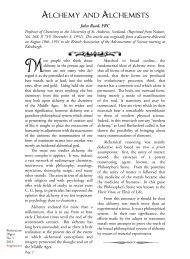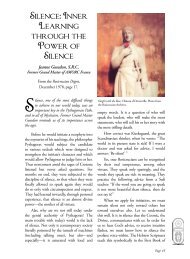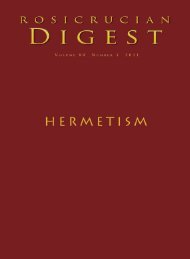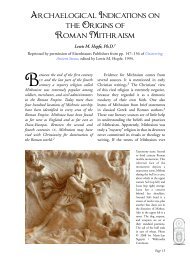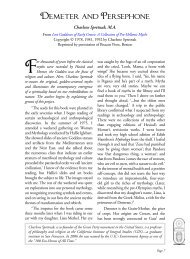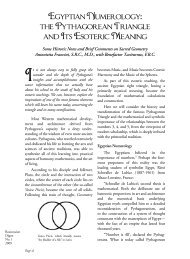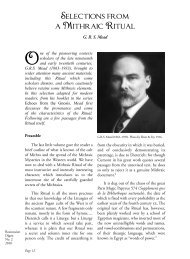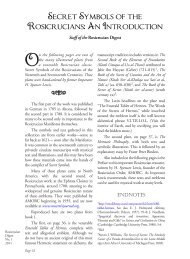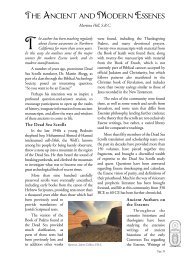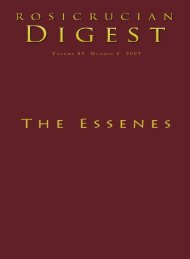Digest - Rosicrucian Order
Digest - Rosicrucian Order
Digest - Rosicrucian Order
You also want an ePaper? Increase the reach of your titles
YUMPU automatically turns print PDFs into web optimized ePapers that Google loves.
<strong>Rosicrucian</strong><br />
<strong>Digest</strong><br />
No. 1<br />
2007<br />
The Mysteries<br />
Such is the purpose of these secret<br />
doctrines and practices called Mysteries, which<br />
were common to the Mediterranean world,<br />
especially ancient Greece, Rome, and Egypt.<br />
Ritual was introduced to change the<br />
quality of the novice’s soul, to raise one’s<br />
consciousness to a superhuman level, and to<br />
make an eternal being out of each soul<br />
personality. Thus the rituals of Adonis or<br />
Tammuz in the Near East, of Osiris in Egypt,<br />
of Orpheus in the Greek Islands, of Dionysus<br />
in Hellas—all depict death and resurrection<br />
so that one may symbolically experience a<br />
superhuman state and eternal life.<br />
Psychologically, these practices resulted in<br />
a true victory over our human fear of death.<br />
Through initiatory death, they were absolutely<br />
convinced that we would be spared the pangs<br />
of death, which is our common human<br />
experience. In fact, they had been saved<br />
because they had been initiated.<br />
The Site of Abydos<br />
We must first go to Abydos in order to<br />
meet the initiates of ancient Egypt. A most<br />
holy city, Abydos, situated between Asyut and<br />
Thebes, sheltered one of the oldest necropolises<br />
in history. There lay the first kings (starting<br />
3200 BCE). A constant religious piety added<br />
to it cemeteries of every period, along the<br />
Libyan cliff, despite the fall of empires. It is no<br />
wonder, then, that nine-tenths of the funerary<br />
steles of the Middle Kingdom (2052 BCE–<br />
1778 BCE) exhibited in the museums of<br />
Europe come from Abydos!<br />
How can we explain this threemillennium<br />
entanglement of necropolises<br />
and this prodigious depository of documents?<br />
The fact is that the city was twice venerable.<br />
Originally the last resting place of the early<br />
pharaohs, it became, at the beginning of the<br />
second millennium, the guardian of the<br />
head of Osiris the Savior, who led human<br />
beings to immortality.<br />
The most precious part of the divine<br />
body dismembered by Seth, the God of Evil,<br />
Page 18<br />
lay in this holy place of Egypt, sheltered in a<br />
shrine surmounted by two feathers. The Holy<br />
Sepulcher was built at the south of the city, in<br />
a place called Peker. At the north stood the<br />
great sanctuary of Osiris, erected at the dawn<br />
of history—beginning with the First<br />
Dynasty—remodeled, destroyed, and rebuilt<br />
several times; all that is left of it today is an<br />
outline, hardly visible, on the site of its<br />
successive ages.<br />
And yet, together with the Holy<br />
Sepulcher, this temple was the crucible of the<br />
Osirian faith. The inestimable relic—the head<br />
of Osiris—conferred upon it an unequalled<br />
aura of holy power.<br />
Has the mind of the masses changed so<br />
much? Paris has protected its unknown hero<br />
in its triumphal arch. Moscow has preserved<br />
the remains of Lenin. It seems that each city<br />
draws its strength from the legacies of its great<br />
dead. Was not Osiris, whose resurrection<br />
promised eternal life to every pious human,<br />
the greatest of them all?<br />
So Egypt wished to die in Abydos. To die<br />
near the god, to rest in the peace emanating from<br />
the Holy Sepulcher, to experience the miracle of<br />
resurrection in its shadow was the dream of an<br />
entire people, from century to century.<br />
Alas, there is nothing left of Abydos today<br />
except ruins and a single bastion: the sanctuary<br />
of Seti I and the strange edifice adjacent to it<br />
called the Osireion.<br />
Part 2: The Osireion Of Abydos<br />
This structure is undoubtedly the most<br />
mysterious in the Valley of the Nile. Its<br />
construction began during the reign of Seti I<br />
(Nineteenth Dynasty, 1300 BCE) and was<br />
entirely underground when originally built. It<br />
comprises a long dark corridor leading into a<br />
hall filled with water. From the center of this<br />
basin rises a rectangular esplanade, a kind of<br />
island surrounded by heavy pillars of pink<br />
granite, to which two staircases lead.<br />
What can be the purpose of this<br />
extraordinary architectural complex? Would it<br />
be a cenotaph of Seti I, whose name is inscribed




